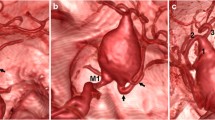Abstract
Background
The superficial temporal artery-middle cerebral artery (STA-MCA) bypass augments blood flow in patients with cerebral ischemia or replaces flow in patients with complex aneurysms or skull base tumors requiring vessel sacrifice.
Method
We provide a description of the STA-MCA bypass with figures and video to illustrate the procedure.
Conclusion
The STA-MCA end-to-side anastomosis is a foundational skill for the cerebrovascular surgeon and a building block for more complex bypasses.




Similar content being viewed by others
References
Amin-Hanjani S, Du X, Mlinarevich N, Meglio G, Zhao M, Charbel FT (2005) The cut flow index: an intraoperative predictor of the success of extracranial-intracranial bypass for occlusive cerebrovascular disease. Neurosurgery 56:75–85; discussion 75-85. https://doi.org/10.1227/01.neu.0000143032.35416.41
EC/IC Bypass Study Group (1985) Failure of extracranial-intracranial arterial bypass to reduce the risk of ischemic stroke. Results of an international randomized trial. N Engl J Med 313(19):1191–1200. https://doi.org/10.1056/nejm198511073131904
Newell DW, Vilela MD (2004) Superficial temporal artery to middle cerebral artery bypass. Neurosurgery 54:1441–1448; discussion 1448-1449. https://doi.org/10.1227/01.neu.0000124754.84425.48
Powers WJ, Clarke WR, Grubb RL Jr, Videen TO, Adams HP Jr, Derdeyn CP (2011) Extracranial-intracranial bypass surgery for stroke prevention in hemodynamic cerebral ischemia: the Carotid Occlusion Surgery Study randomized trial. JAMA 306:1983–1992. https://doi.org/10.1001/jama.2011.1610
Stapleton CJ, Atwal GS, Hussein AE, Amin-Hanjani S, Charbel FT (2019) The cut flow index revisited: utility of intraoperative blood flow measurements in extracranial-intracranial bypass surgery for ischemic cerebrovascular disease. J Neurosurg:1–5. https://doi.org/10.3171/2019.5.jns19641
Thines L, Durand A, Penchet G, Proust F, Lenci H, Debailleul A, Lejeune JP, Pelissou-Guyotat I (2014) Microsurgical neurovascular anastomosis: the example of superficial temporal artery to middle cerebral artery bypass. Tech Princ Neurochir 60:158–164. https://doi.org/10.1016/j.neuchi.2014.03.004
Winkler EA, Raygor K, Caleb Rutledge W, Lu AP, Phelps RRL, Lien BV, Rubio RR, Abla AA (2019) Local in situ fibrinolysis for recanalization of an occluded extracranial-intracranial bypass: technical note. J Clin Neurosci 64:287–291. https://doi.org/10.1016/j.jocn.2019.03.012
Yasargil MG, Yonekawa Y (1977) Results of microsurgical extra-intracranial arterial bypass in the treatment of cerebral ischemia. Neurosurgery 1:22–24. https://doi.org/10.1227/00006123-197707000-00005
Author information
Authors and Affiliations
Corresponding authors
Ethics declarations
Conflict of interest
The authors declare that they have no conflict of interest.
Ethical approval
This article does not contain any studies with human participants performed by any of the authors.
Additional information
Key Points
1. Incise the skin directly over the STA parietal branch to quickly and safely harvest the vessel under the microscope.
2. A targeted craniotomy is performed over the Sylvian fissure to identify potential M4 recipient frontal and temporal vessels.
3. A fish mouth arteriotomy in the STA increases the donor orifice and augments flow through the anastomosis.
4. Marking the M4 recipient arteriotomy with ink allows for a smooth linear arteriotomy and visualization of translucent edges during the anastomosis.
5. Heel and toe stay sutures approximate the STA donor and M4 recipient.
6. Corner stitches should be placed next, as most anastomotic leaks occur at the corners.
7. Taking the corner stitch in two bites allows the surgeon to reorient the needle and angle the second bite back towards the heel or toe stitch and create a tighter seal.
8. Additional interrupted sutures are placed in a single bite, taking care to evert the artery edges. Ink markings help visualize the translucent edges. We place 7 sutures per side in addition to the heel and toe sutures.
9. Most bleeding from the suture line is controlled with application of Fibrillar and gentle pressure.
10. Bypass patency is confirmed with Doppler and ICG video-angiography.
Publisher’s note
Springer Nature remains neutral with regard to jurisdictional claims in published maps and institutional affiliations.
This article is part of the Topical Collection on Vascular Neurosurgery – Ischemia
Electronic supplementary material
A 48-year-old woman presented with TIAs referable to the left hemisphere, despite aggressive medical management with antiplatelet, statin, and antihypertensive medications, and was referred for consideration of bypass. Her MRI showed multiple areas of T2/FLAIR hyperintensity in the bilateral corona raidata and centrum semiovale consistent with remote watershed territory infarcts. CT perfusion showed asymmetrically prolonged MTT in the left hemisphere that increased after administration of acetazolamide. Cerebral angiography showed an occluded left internal carotid artery and moderate to severe right supraclinoid artery stenosis. She underwent an uncomplicated left STA-MCA bypass. Post-operative angiography showed a widely patent anastomosis and robust flow to the left MCA territory. (MP4 445941 kb)
Rights and permissions
About this article
Cite this article
Rutledge, C., Raper, D.M.S. & Abla, A.A. How I do it: superficial temporal artery-middle cerebral artery bypass for flow augmentation and replacement. Acta Neurochir 162, 1847–1851 (2020). https://doi.org/10.1007/s00701-020-04444-0
Received:
Accepted:
Published:
Issue Date:
DOI: https://doi.org/10.1007/s00701-020-04444-0




